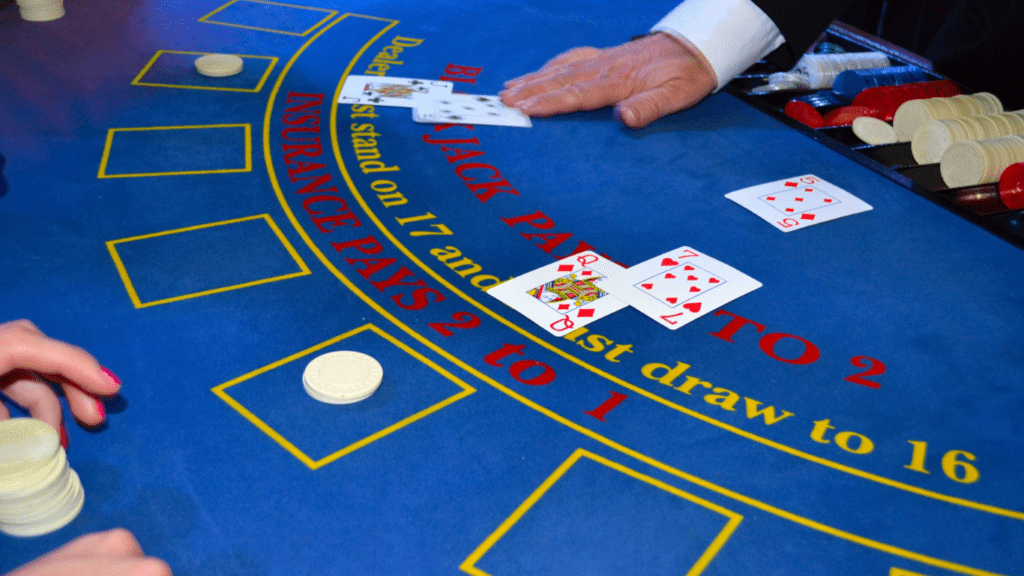Understanding the Basics of Blackjack
Blackjack captivates players with simple rules and strategic depth. Mastering the basics sets a solid foundation for success.
Rules and Objectives
Players aim to beat the dealer by reaching a hand value closest to 21 without surpassing it. Each player receives two cards, face up, while the dealer gets one card face up and another face down (the hole card).
Card values are straightforward: numbered cards retain their face value, face cards equal 10, and aces count as either 1 or 11. Winning requires a strategic blend of decisions concerning when to hit (receive another card), stand (keep current cards), double down (double the bet and take one more card), or split (divide the hand into two separate hands).
Key Terminology
Understanding blackjack’s language aids strategic play.
- Hit involves taking another card to improve hand value.
- Stand means keeping the existing hand, opting for no additional cards.
- Double down lets players double their initial bet for a one-card draw.
- Various blackjack tables offer the insurance option, a side bet against the dealer having blackjack, applicable when the dealer’s face-up card is an ace.
- Bust refers to a hand exceeding 21, resulting in an immediate loss.
- Push occurs when player and dealer hands are equal, leading to a bet return.
Essential Blackjack Strategies
Uncovering essential strategies in blackjack can boost your odds of success. By mastering these techniques, you’ll have a sharper edge against the dealer.
Basic Strategy
The basic strategy outlines the best actions for each hand combination. I start by memorizing actions like:
- hitting
- standing
- doubling down
- splitting
based on the dealer’s visible card. For example, I always stand on a hard 17 or higher and hit on a hard total of 8 or less. Doubling down becomes a smart move when I have a total of 11, especially against a dealer’s 6 or lower. For splitting, I always split Aces and 8s but never split 5s or 10s. This strategy minimizes the house edge and maximizes potential profits by guiding optimal plays.
Card Counting Techniques
Card counting helps track high and low cards left in the deck. By recognizing when the deck is favorable, I adjust my bets. The Hi-Lo system, a popular technique, assigns values to cards: +1 for 2-6, 0 for 7-9, and -1 for 10-Ace. I count these values to assess the ‘true count.’ When the count rises, indicating more high cards remain, I raise my bet. In a low count, I keep bets small, conserving bankroll and minimizing losses. Though not illegal, many casinos frown upon card counting and may ask counters to leave their table.
Bankroll Management

Prudent bankroll management is crucial for staying in control at the blackjack table. By setting limits and tracking wins and losses, I can enhance my chances of maintaining a consistent playing experience.
Setting a Budget
I determine a strict budget before I even enter the casino. This funds allocation allows me to enjoy the game without risking more than I can afford to lose. By dividing my bankroll into smaller session amounts, I ensure that I can play multiple rounds even if I hit a losing streak. Ratios like 1-2% per bet help me manage funds efficiently throughout my session.
Managing Wins and Losses
I keep my emotions in check by deciding in advance when to walk away. Setting win and loss limits helps me avoid needless risks driven by a winning streak or the drive to recoup losses. For example, I might choose to leave the table if I double my initial bankroll or if my losses reach 50% of it. Proper management of my funds prevents chasing losses and solidifies long-term success.
Common Mistakes to Avoid
Understanding common mistakes in blackjack can elevate your game and boost your chances of winning. By identifying these pitfalls, players can refine their strategies and enhance their betting experience.
Ignoring Basic Strategy
Ignoring basic strategy often leads to unnecessary losses. Players sometimes act on gut instincts rather than following proven tactics. Basic strategy charts guide players on the optimal move for each hand against any dealer’s upcard. For example, always splitting aces and eights or never splitting tens can tilt the odds in your favor. Consistently applying these strategies minimizes the house edge and prevents costly errors. Rely solely on these guidelines, not assumptions, to maintain an edge.
Emotional Decisions
Emotional decisions cloud judgment at the blackjack table. Allowing feelings to dictate actions can lead to overspending or chasing losses. For instance, doubling bets out of frustration can deplete your bankroll swiftly. Stay disciplined by sticking to pre-set financial limits and strategies. Approach each hand calmly, focusing on logic over emotion. Detaching feelings from gameplay ensures consistent, rational decisions, preserving both enjoyment and funds.
Tips from Professional Players
To excel in blackjack and consistently outplay the dealer, adopting insights from professional players is key. Their tested techniques can elevate gameplay and refine strategies.
Practice Makes Perfect
Repetition builds familiarity with blackjack strategies. Professional players emphasize regular practice, using tools like online simulators to hone skills without financial risk. Practicing under varied conditions helps players adapt to different game scenarios, enhancing decision-making under pressure. By internalizing basic strategy and experimenting with advanced tactics, I’ve found my gameplay more refined and intuitive.
Staying Focused and Disciplined
Professional players maintain unwavering concentration and control. Staying disciplined involves sticking to pre-determined strategies and avoiding impulsive deviations. High-stakes environments can disrupt focus, but seasoned players block distractions by setting clear boundaries before playing. I’ve seen my decision-making improve by committing to logical strategies and managing emotions efficiently.



 Lead Content Strategist
Willie Maxson is the Lead Content Strategist at Dice Gamblers Deal, where he leverages his extensive knowledge of gambling and content creation to produce educational and engaging material for players at all skill levels. Willie’s background in journalism, combined with a deep understanding of casino games, allows him to break down complex gambling strategies into clear, digestible content that helps readers master the art of winning at the tables. From detailed blackjack strategies to the best slot machine tips, Willie creates resources that provide valuable insights into the world of gambling. His approach is centered around making learning fun and accessible, with content that’s as enjoyable as it is informative. He works closely with the team to ensure that every article, guide, and update on the website is of the highest quality, empowering players to make more informed decisions and ultimately increase their winnings.
Lead Content Strategist
Willie Maxson is the Lead Content Strategist at Dice Gamblers Deal, where he leverages his extensive knowledge of gambling and content creation to produce educational and engaging material for players at all skill levels. Willie’s background in journalism, combined with a deep understanding of casino games, allows him to break down complex gambling strategies into clear, digestible content that helps readers master the art of winning at the tables. From detailed blackjack strategies to the best slot machine tips, Willie creates resources that provide valuable insights into the world of gambling. His approach is centered around making learning fun and accessible, with content that’s as enjoyable as it is informative. He works closely with the team to ensure that every article, guide, and update on the website is of the highest quality, empowering players to make more informed decisions and ultimately increase their winnings.
